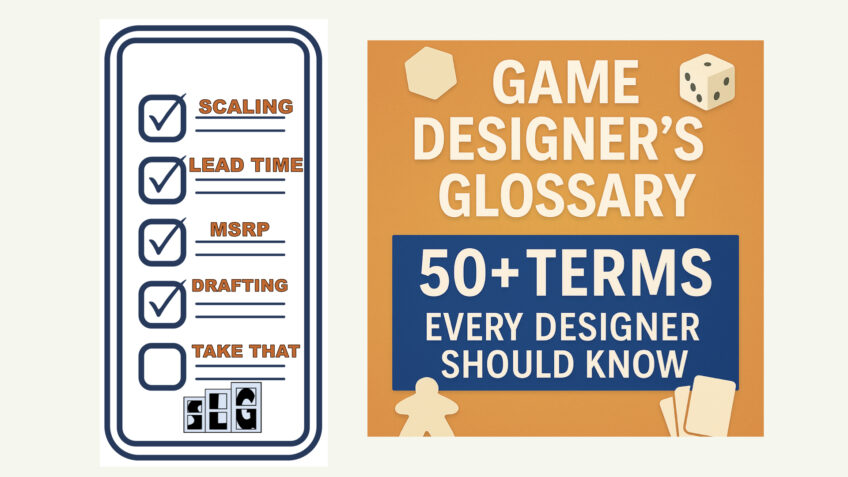Whether you’re designing your first board game or preparing to launch your tenth Kickstarter, the language of board game design can feel overwhelming. From technical terms like “point salad” to production lingo like “punchboard,” there’s a lot to keep up with.
This glossary is designed to help you speak the language of game design — and understand it, too. Bookmark it as a handy reference or share it with friends who are just getting into the hobby!
Core Board Game Design Terms
- Mechanic: The core rules or systems that drive player actions (e.g. worker placement, deck-building).
- Theme: The story or setting of your game — often influences aesthetics and player immersion.
- Component: Any physical piece of the game (cards, boards, tokens, dice, etc.).
- Win Condition: What players must do to win the game.
- Player Agency: The ability for players to make meaningful decisions.
- Replayability: How well the game holds up over repeated plays.
- Downtime: Time when a player isn’t engaged (usually during other players’ turns).
- Fiddliness: When a game has too many small rules, exceptions, or pieces to track.
- Scaling: How well the game adjusts to different player counts.
- Balance: Ensuring that different strategies or factions have fair chances of winning.
Player Interaction & Experience
- Take That: A mechanic where players directly sabotage each other (e.g., stealing or blocking).
- Kingmaking: When a player who can’t win decides who does.
- Quarterbacking (in co-ops): When one player dominates the decisions for the group.
- Analysis Paralysis (AP): When players freeze due to too many choices.
- Catch-Up Mechanic: A feature that helps losing players stay competitive.
- Push Your Luck: A mechanic where players risk gaining more but might lose it all.
Mechanics & Systems
- Deck Building: Building a custom deck over time, as in Dominion.
- Drafting: Selecting from a shared pool of options, often passing to the next player.
- Worker Placement: Assigning tokens to take actions, like in Agricola.
- Action Points: Players spend points each turn to do actions.
- Tile Placement: Adding tiles to create a game board or space (Carcassonne is classic here).
- Set Collection: Gathering related items for bonuses (e.g., matching colors, symbols).
- Area Control: Competing for dominance in certain regions on the board.
- Roll and Write / Flip and Write: Using dice or cards to generate inputs that players write on sheets.
Development & Prototyping
- Prototype: The early version of your game, often made with paper, pens, or software tools.
- Iteration: Making continuous tweaks based on feedback or testing.
- Blind Playtest: A test where players try your game without your explanation or help.
- Rulebook: The instruction manual — a crucial and often underestimated part of the game.
- Component Fatigue: When too many physical elements cause confusion or frustration.
- Table Presence: How visually engaging your game looks on the table.
Publishing & Kickstarter Lingo
- MSRP (Manufacturer’s Suggested Retail Price): What the game will sell for in stores.
- Pledge Manager: A tool for backers to confirm orders after a Kickstarter campaign.
- Stretch Goals: Bonuses unlocked when Kickstarter funding passes certain thresholds.
- Fulfillment: Shipping your game to customers or backers after production.
- Lead Time: The time between ordering production and receiving finished games.
- Punchboard: Thick cardboard sheets used for tokens and tiles.
- Meeple: A human-shaped wooden piece, first popularized by Carcassonne.
- Shrinkwrap: The plastic seal around finished products — adds that “new game” feel.
Bonus Concepts & Terms
- Point Salad: A game where nearly every action gives points, often criticized for lacking focus.
- Eurogame: Games that emphasize strategy, low randomness, and indirect interaction.
- Ameritrash: A (sometimes pejorative) term for games that emphasize theme, conflict, and luck.
- Table Hog: A game that takes up a massive amount of table space.
- Rule Ambiguity: When a rule isn’t clearly written, leading to confusion.
- Iconography: The use of symbols instead of words for actions or effects.
Final Thoughts
Learning the language of game design can help you communicate better with other designers, improve your own creations, and navigate the publishing world with more confidence. You don’t need to memorize everything overnight — keep this glossary handy and refer to it whenever you need.


Theodore4152
https://shorturl.fm/YXTi6
Briana4884
https://shorturl.fm/iJgqY
Acıbadem su kaçak tespiti
Acıbadem su kaçak tespiti Su kaçağı sadece maddi değil, aynı zamanda çevresel bir sorundur. https://social.smileymission.com/read-blog/24711
Jade3104
https://shorturl.fm/u3oHi
Harrison3046
https://shorturl.fm/PReTb
Çapa su kaçak tespiti
Çapa su kaçak tespiti İlk kez bu kadar hızlı bir hizmet aldım, tavsiye ederim! https://somity.xyz/read-blog/4168
Savannah3148
https://shorturl.fm/1cUER
Ramona2796
https://shorturl.fm/9nO0U
Dorothy1958
https://shorturl.fm/8IR1v
Lauren132
https://shorturl.fm/8IR1v
Heath2929
https://shorturl.fm/UZEeO
Dina2001
https://shorturl.fm/t5AZn
Jean3825
https://shorturl.fm/BYjMP
Flora4406
https://shorturl.fm/jC0LZ
Kelsey2415
https://shorturl.fm/H8Din
Justin4778
https://shorturl.fm/oKCFb
Jesus3854
https://shorturl.fm/bPEsP
Cameron439
https://shorturl.fm/o53P0
Marissa954
https://shorturl.fm/n8p3U
Geoffrey3227
https://shorturl.fm/Z1ZBC
Ryder364
https://shorturl.fm/nRuEP
Delaney1432
https://shorturl.fm/YYfey
Casey1881
https://shorturl.fm/VuuNE
Clarence2372
https://shorturl.fm/ueAxo
Audrey2191
https://shorturl.fm/DTnsw
Samantha497
https://shorturl.fm/4ubEl
Nikita1415
https://shorturl.fm/HH3Fz
Blair2931
https://shorturl.fm/VB3kM
Griffin1144
https://shorturl.fm/T8TAi
Krista1259
https://shorturl.fm/3qVnu
Nellie2399
https://shorturl.fm/mggsh
Spencer3018
https://shorturl.fm/kFo3U
Marcel4040
https://shorturl.fm/QpRVz
Brennan2030
https://shorturl.fm/oB0Ie
Simon2741
https://shorturl.fm/0fsKA
Caroline1015
https://shorturl.fm/TP0Ei
Isaac124
https://shorturl.fm/ZrotU
Easton544
https://shorturl.fm/bhTS1
Isla4361
https://shorturl.fm/pyg25
Wade1410
https://shorturl.fm/DxCAC
Kendall233
https://shorturl.fm/pXW5C
Kristin4378
https://shorturl.fm/p5CQW
Aliyah3317
https://shorturl.fm/KzbDe
Evan2796
https://shorturl.fm/UYUuR
Dante2885
https://shorturl.fm/shU7C
Cara1469
https://shorturl.fm/msDP1